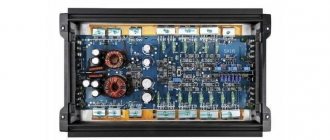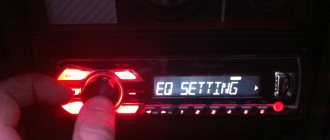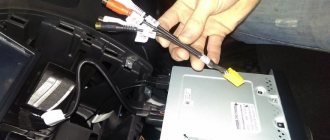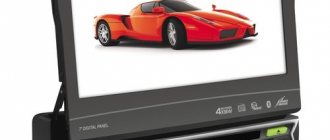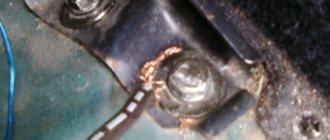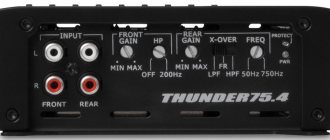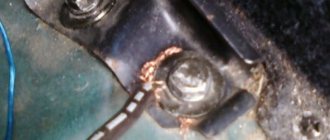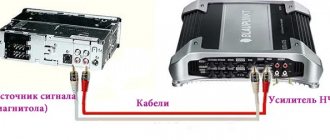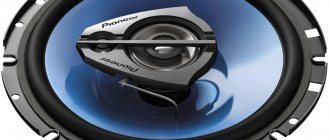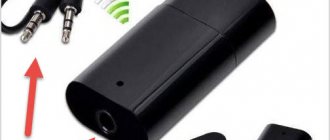- How to connect tulips to a subwoofer amplifier
- Cable for connecting the subwoofer to the radio
- Connection diagram for a subwoofer with a built-in amplifier
- Connecting a subwoofer to a car radio
- Connection diagram for subwoofer to radio without amplifier
- Subwoofer line connection
The low-frequency speaker system provides deep and rich bass sound. For proper operation of the speaker, it is important to connect the system to the sound source and power supply. Correct connection of the subwoofer must be done with special cables of the appropriate cross-section. This will ensure high-quality sound and eliminate the possibility of short circuits.
How to connect tulips to a subwoofer amplifier
Automotive low-frequency systems can be passive or active. A passive bass speaker is a powerful low-frequency speaker installed in a cabinet. This design can be connected to the output of a low-frequency system or directly to the car's stereo system. In order to highlight the low-frequency range and cut off frequencies not intended for reproduction by the bass speaker, the passive system is connected through an LC crossover filter. To get high-quality sound, you need to know how to connect the wires to the subwoofer.
RCA or “Tulip” connectors are often used for interconnecting consumer electronic devices. Connecting a subwoofer through tulips is quick and easy, since such connectors do not have rotary or threaded fasteners. Simply insert the plug into the appropriate socket. The disadvantage of this connection is its low reliability. Low quality Tulip connectors often lose contact due to oxidation of live parts. There are also frequent cases when they come out of their seats due to strong vibration and shaking.
Installation nuances in cars of different brands
The subwoofer and amplifier are placed in the luggage compartment in 99% of cases. But the trunk does not always have sufficient volume. For example, in a VAZ 2114 it is problematic to place a passive subwoofer and amplifier and leave room for transporting something. Therefore, for 2114 it is better to choose an active subwoofer with a suitable housing. Fortunately, car audio stores offer a wide selection of models of different power and configurations.
Take the installation of the power cable seriously. Look for a way to route the power wire through the factory holes. Use rubber or plastic couplings to move from the engine compartment to the luggage compartment. The wire should not come into contact with metal. This will help protect it from chafing and possible short circuits.
For the power cable, it is recommended to use plastic or rubber couplings for transition from the engine compartment to the passenger compartment and from the passenger compartment to the luggage compartment
Self-installation and connection of the subwoofer will take from 1.5 to 3 hours. The procedure is simple, but requires care and precision. If you have doubts about your abilities, contact specialists installing speaker systems. They will select the speaker components and connect them. And after 2-3 hours you will be able to enjoy high-quality surround sound in your car.
- Author: Dmitry Kuznetsov
Let's get acquainted, my name is Dmitry Kuznetsov. Rate this article:
- 5
- 4
- 3
- 2
- 1
(18 votes, average: 3.7 out of 5)
Share with your friends!
Cable for connecting the subwoofer to the radio
Passive and active devices can be connected to the car radio. The only difference is that in a passive acoustic system, the output signal from the music center goes directly to the speaker, and in an active system, the sound signal from the output of the radio goes to the input of the built-in bass unit.
You need to connect the subwoofer speaker to the car radio with wires specifically designed for this purpose. It is not recommended to use electric or low current cables. To properly connect the subwoofer to the radio, only one signal cable is used.
The car's music system has output connectors on the rear wall that are labeled “AudioOut”, “A-Out”, “SpeakerOut” or something else, but the “Out” designation must be present. In addition, the connectors are marked with the letters “L” and “R”, which means left and right channels, respectively. To properly connect a sub, you need to use the output of one of the channels. This can be the left or right channel. In order to avoid possible disconnection of connectors, the cable is firmly fixed in any possible way.
Connection errors
An incorrectly installed audio system not only produces poor sound, but can lead to failure of the head unit, power surges in the on-board network, blown fuses, blown electrical appliances, short circuits and damage to the wiring.
List of common mistakes:
- An overpowered amplifier will damage the woofer. The main selection rule, which reveals the full sound potential of a subwoofer: the power of the amplifier should be less than the declared peak loads of the woofer. You can correctly calculate the amplifier rating using the formula: U – the voltage value of the vehicle’s on-board network with the engine running and powered by the generator = 14.4 Volts;
- I – nominal value of the fuse, or their total value in the case of several separate channels;
- Efficiency (efficiency factor) – constant value: class AB subwoofers – 50% (0.5), class D – 75% (0.75);
- n – number of independent channels of the device.
After installing the subwoofer into the speaker system, adjusting the low frequencies is carried out using a digital equalizer, bringing the speakers to peak loads. Modern devices have a wide range of capabilities and a range of different functions for adjustments (for example, bass boost adjustment, “Bass Boost”, noise reduction mode). Sound correction should be done carefully, not exceeding the signal level by 3 dB. It should be remembered that the increase in power to the woofer occurs multiple times: if you set the bass boost to +10 dB, then the power to the linear input register will be 14 times higher, resulting in overload, fuses blowing, and system components failing.
Connection diagram for a subwoofer with a built-in amplifier
It is more difficult to connect an active subwoofer to the radio, since in addition to the signal wire you will need a power cable. To properly connect the sound system, you need to know where to connect the power cable of the subwoofer amplifier. The subwoofer connection diagram is not difficult, but certain rules for connecting devices must be followed.
The connection between the subwoofer and the amplifier consists of three cable lines. The supply voltage from the battery is supplied to the low-frequency blocking device via the power wire, the signal from the output of the car radio is supplied to the input via the signal wire, and the body or “Ground” of the amplifier is connected to the ground of the car.
The subwoofer is connected to the positive terminal of the battery only through a fuse. Its rating depends on the cable cross-section, which, in turn, is determined by the power of the low-frequency channel. With a wire cross-section of 10 mm2, the fuse should be no more than 60 A; a cable cross-section of 20 mm2 allows the use of a 100 A fuse. A smaller value can be installed, but a larger one cannot be installed, as this can lead to a fire in the event of a short circuit of the positive cable to the housing.
Is it possible to connect the subwoofer directly to the battery. This is absolutely impossible to do, because short circuits in wiring cause more than half of all fires in cars. There are two types of fuses for connecting subwoofer power: AGU and ANL. The second type is much more reliable, so if you have a choice, then you should use it. The distance from the positive terminal of the battery to the fuse should not exceed 30 cm.
The main differences between active and passive subwoofers
To choose between an active and a passive subwoofer, a person must learn about the distinguishing features of each speaker system. Both devices have a common task and a similar design. But what are the differences then?
Passive subwoofer
The passive subwoofer includes a woofer, which is placed in a factory housing. There is no amplifier. The body comes in different shapes and any color, the material is wood/plywood. To transmit sound waves with a passive subwoofer, you need to purchase a separate device for power amplification.
Active subwoofer
An active subwoofer is the same passive subwoofer, but with a crossover filter and a power amplifier in one housing. If you are a person who places a strong emphasis on sound quality, then opt for this device. To connect an active subwoofer to the radio, simply turn on the power and adjust the audio signal.
Advantages and disadvantages of systems
The advantage of a passive subwoofer is rich low bass. The passive device is inexpensive, has the ability to connect additional filters, and has a simple design. The speaker does not overheat during operation.
The disadvantage of this speaker system is the lack of an external power amplifier, as well as wires for connecting it. Because of this, it takes up a lot of space in the car; this must be taken into account when choosing a subwoofer. True music lovers prefer to manually equip the acoustic system with devices that, in their opinion, provide the best sound quality. Therefore, they are much more likely to choose passive subwoofers.
The advantage of an active subwoofer is the presence of an amplifier, crossover filter, and speaker for low frequencies already built into the housing. This means that installation of this device will take less time. An active sub is a compact device.
The speaker system does not take up much space in the car and has a special handle that regulates the signal level. Speakers can be connected directly. This subwoofer is suitable for people who like to listen to rhythmic, heavy music.
Unfortunately, due to the heat generated by the amplifier, the air inside the speaker chamber heats up, which further leads to a deterioration in sound transmission. And operation at critical volume levels can lead to amplifier failure, the reason being an increase in temperature in the case.
So which speaker system is better to choose?
It is impossible to answer with certainty. Each device has its own characteristics. To make the right decision, a car enthusiast needs to take into account his financial capabilities, the characteristics of the vehicle, and also decide on the purpose of using the subwoofer.
To begin installing the subwoofer and connecting it to the car’s on-board network/standard radio, first you should:
- Prepare all necessary materials and tools (list below).
- Select a location to install the speaker system.
- Install and connect the subwoofer.
Connecting a subwoofer to a car radio
The subwoofer is connected to the car stereo using interconnect cables. They have a small cross-section and can be terminated with different types of connectors. In addition to the signal cable through which the sound signal is transmitted, the radio has a “REM” contact. This is a remote control line that allows you to control the power supply to the amplifier. Many people do not use remote power switching, but use a regular toggle switch for manual control. Subwoofer connection photo circuit.
Which radios can you connect a subwoofer to? Usually this is not of fundamental importance, since all models have output connectors for an external amplifier or speakers. To understand where to connect the subwoofer to the radio, just look at its back wall. All connectors there are marked with appropriate symbols. The connectors responsible for input signals are marked with the letters “IN”, the connectors for connecting an external amplifier or speakers are marked with the letters “OUT”, the supply voltage is supplied to the “+12 V” terminal, the “GND” terminal is connected to the vehicle ground. The REM wire can be used to turn on the LF system or use manual control. The connection diagram for the subwoofer to the radio includes only the output wires from which the sound signal is removed.
What wires do you need to connect the subwoofer?
In order to connect a subwoofer, you will need acoustic, interconnect and power wires. Each of these types has a specific functionality. They are often included in inexpensive sets; the quality of such sets cannot be trusted.
- Firstly, the wires may not be long enough for a proper connection.
- Secondly, despite the thick insulation, the wire itself may not be thick enough for such technical loads.
If you have already decided to purchase a set, then pay attention to the manufacturer. Branded kits will be expensive, but they will meet all the necessary requirements.
Ideally, it is better to buy these wires separately. This way, you can control the length, thickness and quality of the purchased wire based on the requirements specifically for your car and speaker system.
The speaker wires are of good thickness and have a copper base. The characteristics of the wire depend strictly on what connectors are provided on the equipment. The interconnect wire is an element in which you should invest the maximum, since here the quality directly depends on its price. The power cable directly affects the safety of the car, so you shouldn’t skimp on it either. The optimal length is around five meters.
Connecting to an amplifier
Connection diagram for subwoofer to radio without amplifier
Connecting a subwoofer directly to the radio is easy even for an inexperienced user. Standard acoustic speakers are connected to the radio via a rectangular Euro connector, which is installed on the rear wall of the device. For additional speakers, front and rear “Tulip” type connectors are used. You can connect the subwoofer to the radio using a standard cable designed for speaker systems. Since the output power of the car radio is small, you can use wires from a ready-made kit to connect the subwoofer to the radio. Conveniently, they are already equipped with “Tulips”. How does a subwoofer play without an amplifier in a car? You should immediately note that connecting the subwoofer directly to the car radio will not provide normal sound. The connection diagram for a passive subwoofer to the radio is limited to one cable line.
The output power of the low-frequency channel built into the radio cannot ensure the effective operation of the low-frequency speaker. The passport for the device indicates that the power of the car radio is 15-20 WRMSTHD 10%. This means maximum sine wave power at 10% THD. With such distortions, listening to music is undesirable, as it is harmful to hearing. A distortion factor of 0.5% is considered the norm, but the output power of the radio should be significantly less. Therefore, when connecting a subwoofer directly, the level of low frequency reproduction will be low.
Features of choosing a speaker for a subwoofer
How to correctly connect an active or passive subwoofer without an amplifier and without a linear output to the standard radio in a car, what to do if there is no such output on the car radio? First you need to understand how to choose the right device for your car. As a rule, subwoofers use speakers with a diameter of 6-15 inches. Many experts advise giving preference to 10-12-inch speakers; such devices are considered the most optimal of all those available on the market. 10-inch speakers are usually used so that the radio can reproduce both front and additional bass.
If you choose a larger option, you should understand that such speakers often distort the quality of the played track. If we talk about power, then in this case there are no clear choice parameters; it all depends on your preferences and capabilities. But it should be noted that the maximum power value in such speakers should be greater than the power of the amplifier. If this is not the case, then again, you will face the problem of sound distortion.
How to connect a subwoofer
The connection diagram of a passive subwoofer to an amplifier in a car is determined by its location and the type of speaker system. For the low-frequency channel to work correctly, it must be connected through a storage capacitor.
A large capacitor plays the role of an additional source of electrical energy. This is necessary for the following reason. The voltage of a car battery is an almost constant value that can decrease, but never increases beyond a certain limit. When playing powerful bass, the current consumption of the system increases so much that even the most powerful car battery is not able to provide it. Despite the large thickness of the wires connecting the audio devices and the power source, there is a voltage drop across them. At such moments, the sound in the low-frequency acoustic system disappears. In the circuit for connecting a subwoofer through an amplifier, a powerful capacitor is connected in parallel with the amplifier and the car battery. When there is a lack of voltage, it almost instantly transfers the energy stored in advance to the amplifier and there are no sound drops. In addition, the storage capacitor protects the woofer and reduces distortion.
In the circuit for connecting a passive subwoofer to a low-frequency channel, the relative position of the elements plays an important role. Since in most cases the low-frequency speaker system is located in the luggage compartment of the car, a capacitor must also be installed there. The wires from the LF unit to the drive should be as short as possible. Since the battery is usually located at the front of the car under the hood, the power cables must be thick enough to handle the large current. The wiring diagram for a subwoofer in a car necessarily includes a fuse. It does not protect the amplifier, since it has its own fuse, but only the cable wiring from possible fire. In the event of a short circuit, the thick wires will heat up so much that the insulation will ignite and a fire in the car is inevitable.
Required tools and materials
To successfully connect a subwoofer with your own hands, prepare the following tools and materials:
- wire cutters;
- knife;
- set of open-end wrenches;
- insulating tape;
- pliers;
- plastic ties;
- power cable;
- speaker cables;
- 60A fuse in the housing;
- plastic pullers for dismantling trim elements.
The length of the wire for powering the subwoofer and speaker cable depends on the specific car model and the possibility of laying the wiring under the trim. The cross-section of the power cable depends on the power of the active subwoofer or amplifier. For example, the power of a subwoofer is 200 watts, divided by 12 (the voltage in the electrical circuit of the car), we get 16.7 amperes. The power cable must withstand this current and not overheat. Based on this, the wire cross-section is selected.
Subwoofer line connection
Sometimes a stereo ULF is used for a low-frequency system. Often household appliances are updated and the old low-frequency unit is used to connect the speaker system. In this case, to properly connect the subwoofer, you need to assemble a simple circuit, which is a voltage divider and a channel mixer. The signal is taken directly from the amplifier's outputs, so its output voltage must be limited.
To connect the wires to the subwoofer, a well-insulated speaker cable is used. This method is also used if the standard car radio does not have an audio output for connecting external speakers. You can make a linear converter yourself or purchase a finished product. When using a ready-made converter, you do not need to connect the wires to the adapter. It is better to install the converter in close proximity to the radio.
Step-by-step instructions for installing an active subwoofer
- Turn off the power to the car and remove the terminals from the battery.
- Route the power cable from the battery to the subwoofer installation location. The wire should not get under the pedals or interfere with the operation of other mechanisms .
- Install a fuse on the wire near the battery. Do not connect the power cable to the battery terminal.
The subwoofer is powered by a rechargeable battery. Be sure to use a fuse to avoid wiring troubles - Remove the original radio and inspect the rear panel. Locate the line output for the subwoofer and the control wire.
Find the linear output for the subwoofer and the control wire - Route the speaker cables and REM (System Remote Control) wire from the radio to the subwoofer location. Place the wires under the trim elements and secure them securely with plastic clamps.
All wiring is laid under the trim elements of the car interior. It is securely fastened with plastic clamps - Connect the control wire, speaker cable, power and ground wires to the subwoofer. Take the “earth” from the metal surface of the car body.
- Connect the sub and REM wire to the radio. Carefully insulate the twisted areas. Install the radio in its original location.
- Connect the power cable to the “+” terminal of the battery.
List of required components
To begin with, let’s decide on a general list of parts, namely their name and function, and then give a recommendation for selection.
- Power wire. Supplies power from the battery to the amplifier. For a medium-sized sedan you will need 5 m of “plus” and 1 m of “minus”. You can get more accurate dimensions by measuring your car yourself.
- Bulb with fuse. An important component. Serves as protection in the event of a short circuit in the power cable.
- Terminals. Allows you to simplify the connection of power wires to the battery and car body. You will need 2 pcs. ring type. If the connection to the amplifier is on the blades, you will need 2 more pieces. fork type.
- Tulips and control wire. Transmits an audio signal from the radio to the amplifier. Can come complete with interconnect cables or be purchased separately.
- Speaker wire. Transfers an improved signal from the amplifier to the subwoofer. You will need 1-2 m. If you have an active subwoofer, this wire will not be needed.
- Additionally, a distributor may be needed if two amplifiers are installed.
Determining the power of the audio system in a car
Calculating the power of the audio system will allow you to choose the right power cable. To do this, you need to know the rated power of all amplifiers installed in the car. You can look it up in the instructions or find it by the name of the active subwoofer or amplifier on the Internet.
If, in addition to the subwoofer, an amplifier is also installed on the speakers, the power of all amplifiers should be summed up.
For example, your car has 2 amplifiers. The first is for a subwoofer with a power of 300 W, the second is a 4-channel with a channel power of 100 W, installed on speakers. We calculate the total power of the audio system: 4 x 100 W = 400 W + subwoofer 300 W. The result is 700 W.
It is for this power that we will select the power wire; if in the future your audio system is replaced with more powerful components, we advise you to choose wires with a reserve.
A set of cables for a subwoofer, a budget option for weak systems
A common option is to purchase a ready-made set of wires. This solution has its advantages. Firstly, such kits are inexpensive. Secondly, the box contains everything you need to connect.
There is one minus. These kits use aluminum wires coated with copper. They have high resistance, which affects throughput. Depending on conditions, they oxidize and rot over time. This option is suitable for those who have a modest budget and low system power, for example, for connecting an active subwoofer.
Best active
The rating of active subwoofers, compiled based on customer opinions, includes products collected by various car audio manufacturers. In addition to brands such as Pioneer or Alpine, the rating includes products from Chinese companies Supra, Mystery or Kicx. All products are equipped with shock-resistant housings that prevent damage to electronic components. Additional pads are installed inside the casing to provide improved bass sound and reduce the risk of vibration of parts when the subwoofer is operating.
Pioneer TS-WX210A
The best active subwoofer from Pioneer has a flat body with a thickness of 110 mm. The design of the product uses an 8-inch speaker with a strontium magnet, the power of the built-in amplifier does not exceed 150 W. The product is equipped with a remote control, and a rotary bass regulator is installed on the body. The device is intended to be attached only to a horizontal surface in the luggage compartment.
Alpine SWE-815
The equipment is equipped with an external sound level control and low-pass filter (wired control panel), the speaker cone is covered with a durable protective grille. The built-in amplifier has a peak power of 150 W, the reproduced frequency range lies in the band from 34 to 1500 Hz. The design provides a crossover that provides a cutoff frequency of 50-125 Hz. The equipment body is made of MDF board covered with parquet on top.
Supra SRD-T30A
Supra active subwoofers provide ultra-low sound frequencies in the range of 28-250 Hz. The equipment is equipped with a cylindrical housing in which a 12-inch speaker with a standard winding and a neodymium magnet is mounted.
Mystery MTB-300A
The MTB-300A equipment is equipped with a bass reflex housing of a cylindrical configuration with a cut-off bottom plane. The design uses a 12-inch speaker, working in conjunction with a 360 W MOSFET amplifier. The product reproduces sound in the frequency range from 40 to 250 Hz, the Bass Boost mode control is installed. Remote control of operating parameters is provided.
Kicx ICQ-300BA
The product from the Chinese manufacturer Kicx, which produces home and car acoustic components, has a maximum power of 500 W. The loudspeaker allows you to reproduce frequencies from 25 to 800 Hz, the sensitivity of the device is 90 dB. To make the body, an MDF board covered with thick felt is used. The device weighs 15 kg, the speaker cone is protected by 2 metal brackets.
Home theater connection
By home theater, users mean different sets of devices. This is either multi-channel acoustics or a set of TV, player and speakers. Next we will look at two options:
- How to use a PC as a source of sound and image by connecting a TV and speakers to it.
- How to directly connect existing cinema acoustics to a computer.
Option 1: PC, TV and speakers
In order to reproduce sound on speakers from a home theater, you will need an amplifier, which is usually a supplied DVD player. In some cases, this may be a module built into one of the speakers, for example, a subwoofer. The connection principle in both situations is identical.
Option 2: Direct speaker connection
This connection is possible if the amplifier and computer have the necessary connectors. Let's look at the principle of operation using the example of acoustics with 5.1 channels.
- First we need four adapters from 3.5 mm miniJack to RCA (see above).
- Next, we use these cables to connect the corresponding outputs on the PC and the inputs on the amplifier. To do this correctly, you need to determine the purpose of the connectors. In fact, everything is quite simple: the necessary information is written next to each slot.
- R and L (Right and Left) correspond to the stereo output on the PC, usually green.
- FR and FL (Front Right and Front Left) are connected to the black “Rear” jack.
- SR and SL (Side Right and Side Left) – to gray with the name “Side”.
- The center speakers and subwoofer (CEN and SUB or SW and CE) are connected to the orange connector.
If some sockets on your motherboard or sound card are missing, then some speakers will simply be unused. Most often, only a stereo output is available. In this case, the AUX inputs (R and L) are used.
It is worth keeping in mind that sometimes, when connecting all 5.1 speakers, the stereo input on the amplifier may not be used. It depends on the principle of its operation. Connector colors may differ from those shown above. Detailed information can be found in the instructions for the device or on the manufacturer’s official website.
Sound settings
After connecting the speaker system to your computer, you may need to configure it. This is done using the software included with the audio driver, or using standard operating system tools.
Read more: How to set up sound on your computer
Conclusion
The information provided in this article will allow you to use the equipment at hand for its intended purpose. The process of creating a symbiosis of a home theater with a computer is quite simple, you just need to have the necessary adapters available
Pay attention to the types of connectors on devices and adapters, and if you have difficulties determining their purpose, read the manuals
Describe what didn't work for you. Our specialists will try to answer as quickly as possible.
Car subwoofer: types and design features
You don't need it to listen to most music tracks. A sub is needed for high-quality sound of low frequencies (bass).
Subwoofers come in two types:
- Active - they already have a built-in power amplifier;
- Passive - there is no amplifier and requires additional connection so that the output sound is clear without distortion or interference.
A passive subwoofer may look like a regular large speaker or a box in which the speaker is placed.
Structurally, an active sub consists of the following elements:
- body - wooden or plastic;
- woofer;
- signal regulator;
- amplifier;
- signal frequency regulator.
For high-quality sound, the active sub must be correctly connected to the radio.
Types of subwoofers by design:
- Horn - the type has a folded horn-speaker, used at concerts;
- Closed - is a speaker installed inside and tightly adjacent to the walls of a closed box;
- Bass inverter - a type using a ventilation pipe, from which, under the force of sound waves, air comes out along with low-frequency sound;
- Quarter-wave resonator - acoustics with a tunnel design, a tunnel-pipe, of a given length and cross-sectional size through which sound comes out;
- Bendpass is a box with a bass inverter, divided in the middle by a wall into two chambers, different in volume, the speaker is placed in the partition between them.
